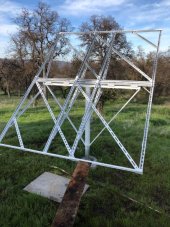It is more a question of what can I run with what I have now. NO plans to add more panels, I think 1500 watts will take care of all of the loads.
People always tend to under estimate the watts they consume, and over estimate the power panels will produce. So, most likely your plans are going to change whether you want to or not. You'll find out soon.
Most likely, there is not a scenario where you can parallel the 100W panels with the 160W panels for the kind of distance you are working with. 125' is very doable though. That's about what the distance I am running one of my arrays from the controller. To give you a really accurate design strategy, we need to know the specs on your panels. I'll guestimate and say that the 100W panels have a Vmp of 20V and a Voc of 24V, putting out ~5A. The 160W panels might have about the same voltages, but putting out ~8A.
If you have a 200V controller, like an Epever Tracer 5420, you could wire 6 of your 100W panels in series to get a Vmp of 120V, and an open circuit voltage of 144V. At freezing, the Voc will bump up to ~161V. What are your winter lows like? If you wired all 7 in series, you'd get 140Vmp and 188Voc at freezing. Maybe seven in series is too risky for a 200V controller. Midnight and Outback make 250V and 300V controllers respectively, but are far more pricy then Epever.
If you wired 6 panels in series for 144V, you could make two parallel strings of those, 6S2P, for 1200W total. But then you are stuck with 6 panels you can't otherwise use. You can't put the 160W panels in series and place them in parallel with the 100W panels, because that string would only have a Vmp of ~ 80V, and all parallel strings MUST be the same voltage. Another alternative is to put 12 of the 100W panels as 4S3P, and wire the 4 160W panels as a fourth parallel string, but you'd waste two 100W panels, and would have more voltage drop across the 125' distance. The higher voltage option, passing 144V though 10 gauge wire, will have very little voltage drop over a distance of 125 feet.
Normally, you don't want to place different amperage panels in series together, because the lower amperage panel will drag the higher amperage one down to it's level. You have two options here. Buy two more 160W panels so you can wire them all in series together, producing a third string making 8A at ~144V, or wire the four 160W panels in series with the two left-over 100Wers, and just settle for losing 3 amps off of the third string.
That would give you three strings of panels putting out ~5A at 144V, or about 2160W total.
BTW, what system voltage are you planning on operating at? Assuming your panels only output 85% of rated power, that's still 147A when charging at ~12.5V. That is a LOT of amps. With a 24V bank charging at 25V, that's only 74A, and only ~37A charging a 48V bank. A 40A charge controller is going to be way cheaper than a 150A controller.




